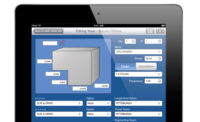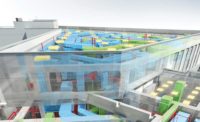
A sample of BIM models of McQuay HVAC systems. (Click on the image for an enlarged view.)
Architects; mechanical, electrical and plumbing (MEP) designers; and contractors have used traditional CAD-based libraries supplied by building product manufacturers, primarily for the geometric data that describe the products. BIM goes further than traditional CAD drawings by providing intelligence to individual building components (e.g., windows, walls, or chillers) as well as providing system- and building-wide information and awareness (system flows or building loads) in addition to simple spatial relationships.
When the design is implemented using traditional 2D CAD files, the risk that on-site changes will be required - for example, re-routing piping or ductwork to avoid obstructions not detected in the original design - increases, which can ultimately impact both the project timeline and building cost.
Also driving the BIM trend is the increasing requirement for designers to provide more accurate energy modeling data in support of energy conservation incentives and/or sustainable building programs such as Leadership in Energy and Environmental Design (LEED®) certification. The ability to precisely lay out an HVAC system as it will be installed can be critical in providing the most accurate energy model for the building.

The building information modeling process. (Click on the image for an enlarged view.)
WHAT IS BIM?
While many people intuitively think of BIM as software, in reality BIM is theprocessof creating and using digital models for design, construction and/or operations of building projects. Software is simply the mechanism by which the BIM process is accomplished.The BIM process involves participants from the entire project life cycle (architect, engineer, contractor, owner, facilities management, etc.) who all contribute and communicate through the shared models.
These models combine intelligent 2D and 3D objects used to define a building design, along with external factors such as geographic location and local conditions, into a virtual building database that provides a single, integrated source for all information associated with that building’s design.
The “intelligence” attributed to the objects includes parametrically-defined graphical and non-graphical information, giving the architects, MEP engineers, and contractors the ability to represent geometricand functionalrelationships between building elements.
This information feeds an integrated database, which in turn feeds all design documents and schedules for the building project. When a change is made to the building model, all graphical views (plan, elevation, detail, and other construction drawings), as well as non-graphical views such as the design documents and schedules, automatically reflect the change.

Shown is a primary school interior with a McQuay BIM model incorporated. (Click on the image for an enlarged view.)
KEY ADVANTAGES OF BIM
Improved information flowBecause a digital model represents a unified description of a building, it can significantly improve the flow of information in every stage of the design, construction, and life cycle of a building.
The digital model can be accessed by the architects, MEP engineers, contractors, facilities managers, and owners at different phases in the building life cycle to add, extract, or modify information in support of their role. A clear vision of the project is maintained to promote informed decisions, reduce errors, and improve productivity.
Better design visualization
The ability to predict how occupants, visitors, and neighbors will react to and interact with a building is a crucial part of the design process for architects and engineers. But the virtual building model created during the BIM process also provides an important benefit in helping MEP engineers optimize the layout of the HVAC system within the space constraints of the building design.
Whether placing an air handler in a mechanical room, or routing piping or ductwork, the ability to virtually build the HVAC system and visually examine it in 3D can provide added assurance that all components will fit when construction begins.
Improved cost estimating
BIM can simplify and help provide better cost estimates because of the depth and precision of the information it provides. The relative ease with which material and assembly quantities can be extracted from the model can increase the speed and accuracy of estimates, providing a better gauge of the impact of design changes so that budget concerns can be dealt with proactively.
Improved energy analysis
Here again, BIM can simplify and improve the accuracy of energy analysis because the data required to perform such analysis is resident in the digital building model.
Reduced construction costs
Clash detection can be used long before construction begins to show where parts of the design occupy the same space. This can reduce or eliminate the need for changes in the field during construction.
BIM models can also be used to help prefabricate building components, such as duct or pipe runs, with confidence. This can save in costs associated with assembly and installation.
Building history
As a building passes through design, construction, and into occupancy, the digital model can serve as an important information library for owners and service contractors. For example, if a building component fails, the building information model can be used to identify its location, manufacturer, model number, performance specifications, and other pertinent data to most efficiently repair or replace that component.
If a portion of the building is being remodeled, the building information model can be used to identify concealed components, such as piping, ductwork, and electrical equipment to promote informed decisions on the remodel design.

Here is a school fancoil application represented using BIM. (Click on the image for an enlarged view.)
BIM SOFTWARE
Major architectural, engineering, and construction (AEC) software providers, such as Autodesk, Bentley, Gehry Technologies and Graphisoft, provide the core software necessary to create a digital building model.While the predominant users of these software packages have primarily been architects, use among MEP engineers and contractors has been rapidly expanding as more benefits of the technology are exposed and as the market demands tighter control of the design process to achieve productivity, cost, and sustainability goals.
Software providers have been enhancing their products to provide better support for functions that, in the past, have been separate from the geometric design of the building. These functions include such things as energy analysis, cost estimating, construction scheduling, and facilities management. This allows an increasingly more complete solution for the various disciplines involved in the buildings market.
WHERE DOES BIM CONTENT COME FROM?
BIM relies upon 2D and 3D parametrically-defined objects which also allow the storage of non-graphical information in them to design the most accurate building model.In many cases, these objects represent building components, such as HVAC equipment. The objects should ideally be provided by the manufacturer to ensure the most accurate representation of the actual products to be used during construction. While it is possible to use a generic object as a placeholder, the building information model will not be complete until the manufacturer’s accurately-defined object is included.
Manufacturer websites are a good source for finding BIM content. However, given the number of components that comprise a building, and the number of manufacturers supplying those components, it can be overwhelming to manually search for BIM content on individual manufacturer websites.
There are several websites available that provide libraries of BIM content. Among the most popular sites are Autodesk® Seek and the McGraw-Hill Sweets Network. The search capabilities on these websites can be powerful and allow you to pinpoint content quickly.
SUMMARY
It is almost a foregone conclusion that the use and sophistication of BIM will continue to grow as more of the benefits of the technology become evident.The number of buildings designed using the technology and the number of BIM users has grown dramatically over the past few years and this trend is expected to continue. If you are not already using BIM, you should consider getting involved.
For more information on BIM, a good starting point might be the Whole Building Design Guide website (http://www.wbdg.org/bim/bim.php) or the websites of BIM software providers. The American Society of Heating, Refrigerating and Air-Conditioning Engineers (ASHRAE) also provides a free Acrobat PDF download (http://cms.ashrae.biz/bim/) “An Introduction to Building Information Modeling.”
Reprinted and updated with permission from the McQuay Engineering System Solutions newsletter “A Brief Introduction to Building Information Modeling (BIM).” For more information on McQuay products and BIM capabilities, visit www.go.mcquay.com/ads/BIM400.
Publication date:04/18/2011









